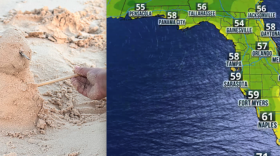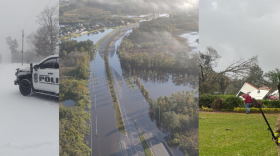WATER QUALITY REPORT FOR FEB. 4, 2024
There are a lot of people talking about the high level of water in Lake Okeechobee at 16.3 feet as of Sunday, which is higher than this time last year when it was at 15.97 feet and two years ago when it was 14.91 feet.
Thanks in part to the newly strengthened Herbert Hoover Dike running around the Big Lake, there is new confidence in its ability to hold water up to its possible high point of 17.25 feet.
The Army Corps does not want the lake to get above 17.25 feet or below 11.98 feet, which in military engineering-speak is called the lake’s “Operational Management Band,” because depending on whether one is talking about the low end or the high end there are risks to the flora and fauna in the lake, to the estuaries to the east and the west, and of course, flooding should a worst-case-scenario occur.
There have been a lot of worst-case scenarios come true with the weather during the last two or three years, and most scientists say there are more to come if we continue to fail to take global warming seriously enough to do something about it.
Stop burning fossil fuels would be an excellent start.
NOAA is reporting the precipitation outlook favors well above-average precipitation in the southeastern parts of the country this month.

Captains for Clean Water, a locally-based nonprofit that works to track algae blooms and lobby for cleaner waters inland and offshore, weighed in on the current height of the water in Lake O and expressed its concerns that the deepness will lead to high levels of discharge out the estuaries – in our case the Caloosahatchee River and its tender estuary.
“We don't know for sure what the future will hold, but with these current conditions, it definitely increases the potential for high-volume discharges in the coming months,” the clean water group wrote on Facebook. “Although these conditions aren't what we want to see right now, it's important to recognize that we likely would've already been getting discharges a long time ago if it weren't for progress that’s been made in lake operations and restoration infrastructure.”
And then a kudo for Army Corps’ management of the situation, which was rather unheard of in the past.
“Thankfully, in recent years, the Army Corps has been managing the system in a way that is much better for the health of our waters and makes every effort to mitigate harmful coastal discharges.”
Let’s hope the captains in Captains for Clean Water have it right.
RED TIDE
Florida Fish and Wildlife Conservation Commission sampled for the red tide organism, Karenia brevis, and it was not observed in samples collected statewide over the past week.
No reports of fish kills suspected to be related to red tide were received over the past week, nor was there any respiratory Irritation reported in Florida over the past week related to the harmful algae bloom..
BLUE-GREEN ALGAE
The Florida Department of Health has issued a warning for blue-green algae near the Midpoint Bridge leading into Cape Coral, for the canals by Southeast 23rd Street and Southeast 11th Place, after testing found the conditions ripe for a bloom.
The agency reminds residents that winds and tides tend to push the components of blue-green algae around, so people in that region should be watchful for the potentially toxic bloom.
The most recent satellite imagery for Lake Okeechobee shows widely scattered bloom potential on visible portions of the lake with the northern portion of the lake showing the lowest bloom potential.
The most recent satellite imagery for the Caloosahatchee estuary shows low-to-moderate bloom potential in the upper portion of the estuary.
The FDEP says it is important to remember the blue-green algae potential is subject to change due to rapidly changing environmental conditions or satellite inconsistencies.
What is red tide?
Red tide is one type of harmful algal bloom caused by high concentrations of the toxic dinoflagellate K. brevis, which is a type of microscopic algae found in the Gulf of Mexico.
Red tide typically forms naturally offshore, commonly in late summer or early fall, and is carried into coastal waters by winds and currents. Once inshore, these opportunistic organisms can use nearshore nutrient sources to fuel their growth.
Blooms typically last into winter or spring, but in some cases, can endure for more than one year.
Is red tide harmful?
K. brevis produces potent neurotoxins that can be harmful to the health of both wildlife and people. Wind and wave action can break open K. brevis cells and release toxins into the air. This is why you should monitor conditions and stay away from beaches where red tide is in bloom.
People in coastal areas can experience varying degrees of eye, nose and throat irritation during a red tide bloom. Some individuals with chronic respiratory conditions like asthma or chronic lung disease might experience more severe symptoms.
Red tide toxins can also affect the central nervous system of fish and other marine life, which can lead to fish kills.
What causes red tide?
A red tide bloom develops naturally, but recent studies have discovered mankind's infusion of other nutrients into the mix can make the red tide last longer or get stronger. But biology (the organisms), chemistry (natural or man-made nutrients for growth) and physics (concentrating and transport mechanisms) interact to produce the algal bloom. No one factor causes the development of a red tide bloom.
What is blue-green algae?
Blue-green algae, also known as cyanobacteria, are a group of organisms that can live in freshwater, saltwater or brackish water.
Large concentrations, called blooms, can change the water color to blue, green, brown, orange or red. Some cyanobacterial blooms can look like foam, scum, or mats on the surface of freshwater lakes and ponds. As algae in a cyanobacterial bloom die, the water may smell like something with a naturally unpleasant odor has now started to rot, too.
Is blue-green algae harmful?
Different types of blue-green algal bloom species can look different and have different impacts. However, regardless of species, many types of blue-green algae can produce toxins that can make you or your pets sick if swallowed or possibly cause skin and eye irritation.
The FDEP advises staying out of water where algae is visibly present as specks or mats or where water is discolored. Pets or livestock should not come into contact with algal bloom-impacted water or with algal bloom material or fish on the shoreline. If they do, wash the animals right away.
What causes blue-green algae?
Blue-green algae blooms occur when the algae that are typically present grow in numbers more than normal. Within a few days, a bloom can cause clear water to become cloudy.
Winds tend to push the floating blooms to the shore where they become more noticeable. Cyanobacterial blooms can form in warm, slow-moving waters that are rich in nutrients. Blooms can occur at any time, but most often occur in late summer or early fall.
If any major type of water quality alert is issued, you can find the details here in WGCU’s Water Quality Report.
Environmental reporting for WGCU is funded in part by VoLo Foundation, a non-profit with a mission to accelerate change and global impact by supporting science-based climate solutions, enhancing education, and improving health.
Sign up for WGCU's monthly environmental newsletter, the Green Flash, today.
WGCU is your trusted source for news and information in Southwest Florida. We are a nonprofit public service, and your support is more critical than ever. Keep public media strong and donate now. Thank you.








